In India, where cows are holy, eating beef is a political act. But for the Muslims of the old Mughal city of Hyderabad, home to the famous Kalyani biryani, it is also a way of life — albeit one that in recent years has been driven underground. .
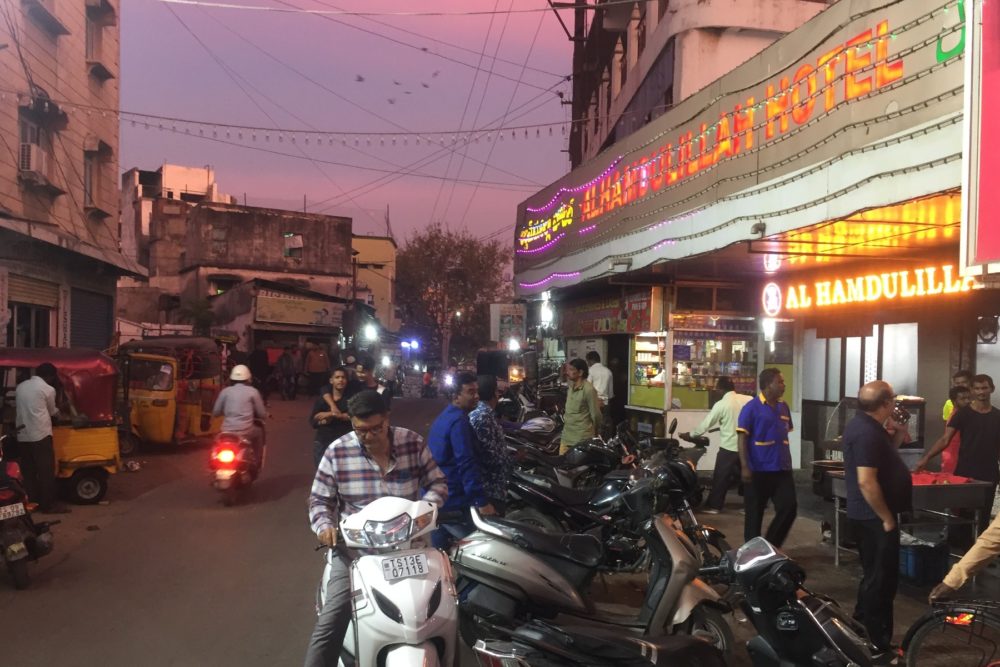
The Al Hamdulillah Hotel in Hyderabad at sunset (Photo: Chris Newens)
Abdul Sattar seems more crime boss than restaurant owner. A large man and old, but with a coiled vitality, or maybe it’s violence; he even has a consiglieri – a pruney secretarial assistant through whom all my questions are passed.
We talk at a corner table of Sattar’s Al Hamdulillah Hotel, while my guide Rahal translates. The late-afternoon restaurant is coming to life, the smells of this low-slung complex in Hyderabad’s old town are of wood smoke and saffron and of course of meat, and we are four men having the conversation of two.
Everything is discussed and debated before it reaches my ears, what can and can’t be said approached as delicately as the ingredients of the biryani that has made the Al Hamdulillah’s name. For we are talking about beef in Hindu India, which means there are lives as much as livelihoods on the line.
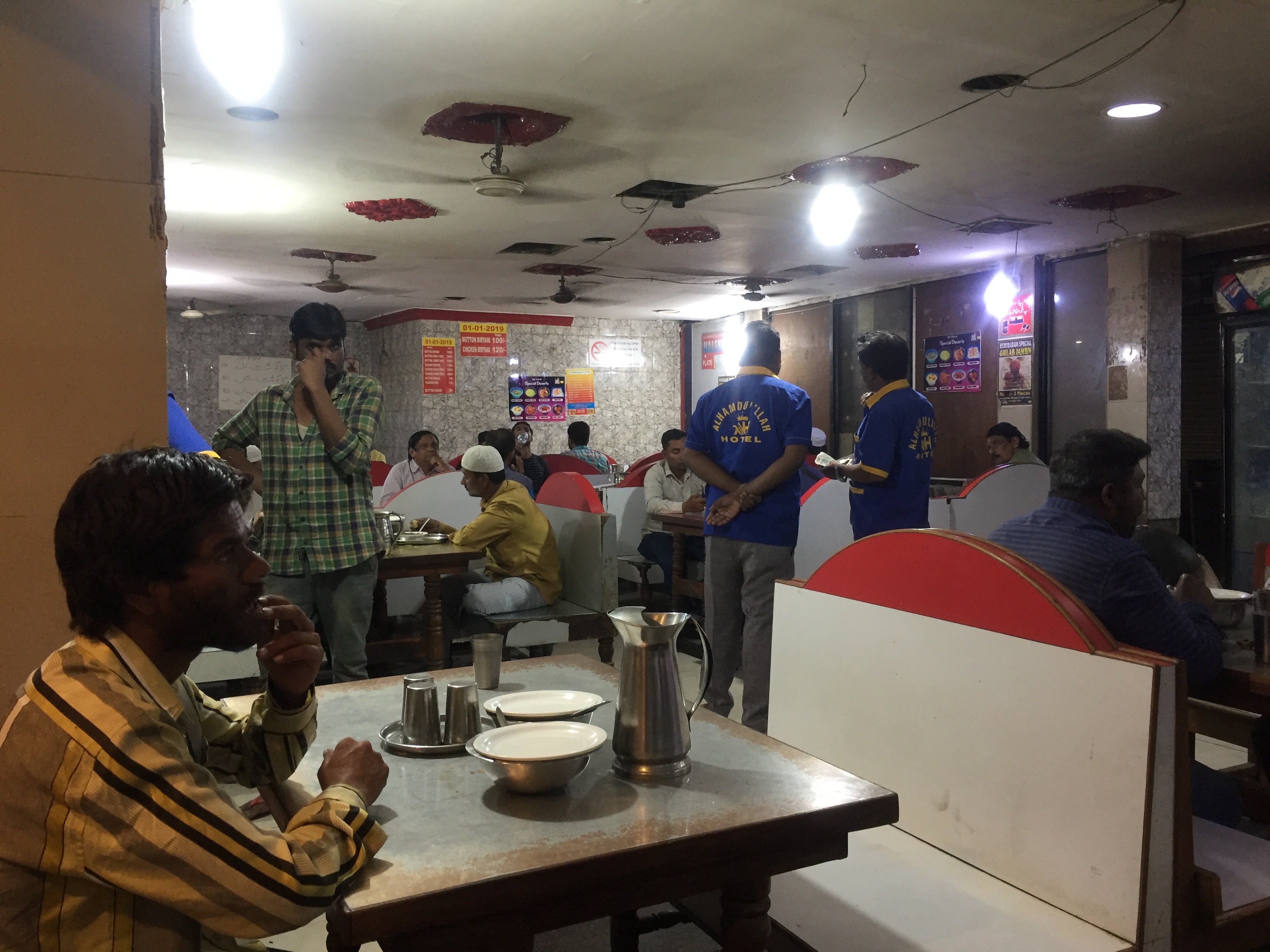
Inside the Al Hamdulillah (Photo: Chris Newens)
Once upon a time Hyderabad was a Muslim town. As capital of the Mughal Asaf Jahi dynasty, it was one of the great centres for Persian-style architecture, literature, and food anywhere on the subcontinent. The edifices of that civilisation remain, though they are tired now and crumbling – and often dressed in neon. For Hyderabad offers in its purest form what AA Gill once wrote about all of India: that it is the world with the hood up. Life and its accoutrements are everywhere: in the Indy 500 road junctions, and in the nuts and bolts, and back-axels and microchips that literally spill onto the pavement; and in the way in which The Hustle here has taken on an almost physical form, how a walk down the street is a cartwheel through samsara, past tech bros in their Gucci loafers and lungi-ed geriatrics squatted over soldering irons, past women in saris, past women in hijabs, and past curb-side preachers, sore-pocked beggars, cloth merchants, iron mongers, and chicken sellers. And past cows.
Against all this, the city’s Mughal history can seem buried. Even the great Mecca Masjid mosque feels forgotten. Its fountain is clogged, there are pigeons nested in its rafters, and huge dust-covered sheets hang from the ceiling. Like fossilised tears. But then, perhaps being forgotten is just what the city’s Muslims want right now – at least when it comes to their diet.
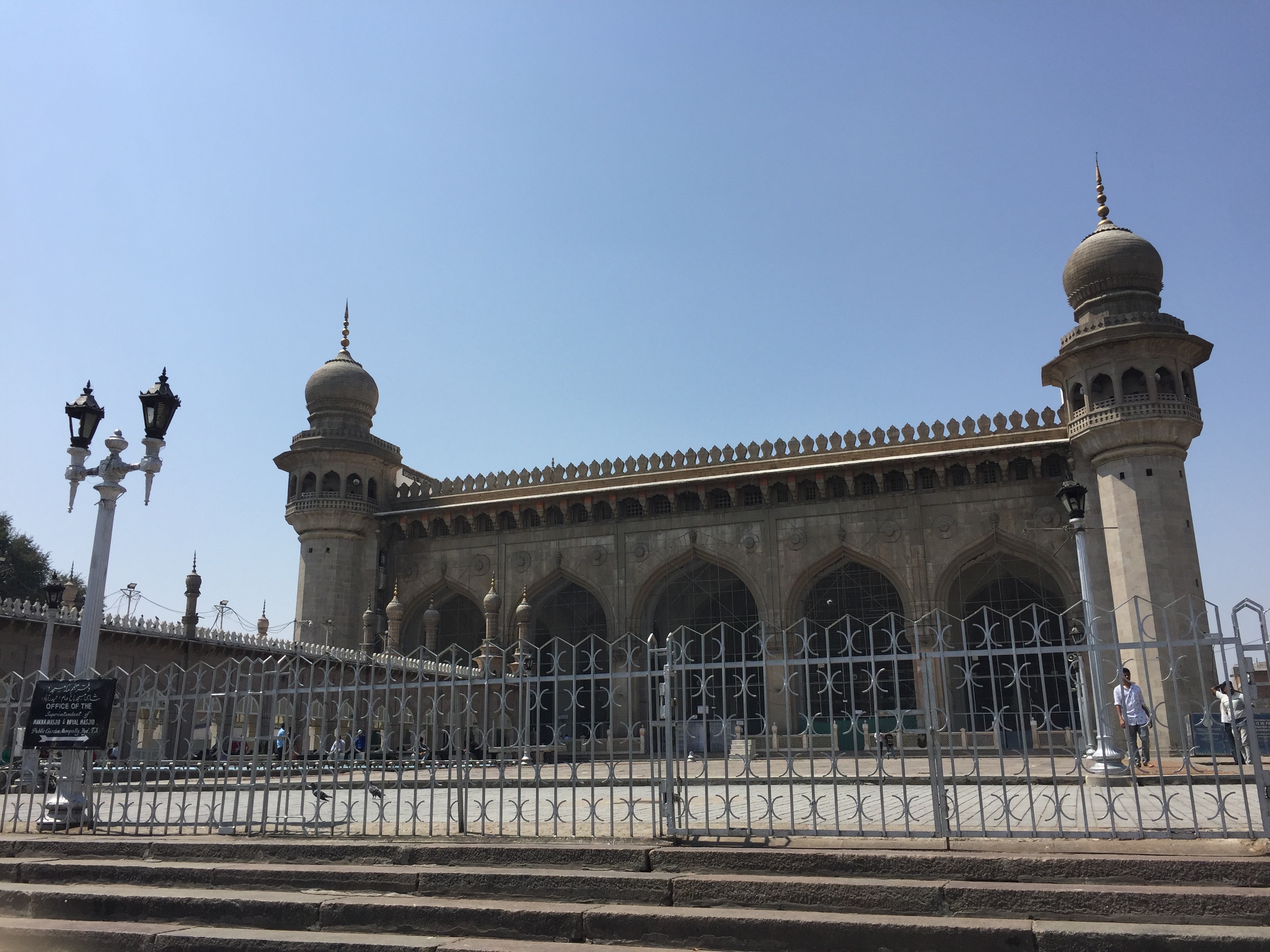
Outside the Mecca Masjid mosque (Photo: Chris Newens)
Once it was known far and wide that travellers to Hyderabad’s palaces would be welcomed by the city’s nawabs with not just one, but two helpings of biryani. There’s even speculation that this is where the dish originated. The fragrant meal of mixed rice and Indian spices served in restaurants from Calcutta to Cochin is certainly regarded as a Mughal invention – and being Muslim, and ruling much of the country at that stage, the nawabs thought nothing of cooking it up with their favoured of all meats: beef. Neither the Mughals nor their palaces remain, and thanks to the changing religio-political state of modern India, their beef biryani has become an underground dish, cooked up under the pseudonym “Kalyani”, almost never appearing on menus, and served only in discreet Muslim restaurants, mostly in the run down old centre of the city.
For beef is no ordinary meat in this country. Among India’s dominant Hindu population, the cow is sacred. It is not only a giver of milk and curd and ghee and the historic building material of dung, but a gift from the gods; and among the ever-growing Political Hinduism movement it is emphatically not to be killed and eaten. This may be questionable regards actual Hindu theology (suffice to say opinions differ), but that’s not prevented the majority of Indian states outlawing both cattle sale and slaughter. Paradoxically, in the states where cattle slaughter is not illegal the industry is so large as to make India the second largest exporter of beef in the world. This has sparked a wave of anger among a whole generation of young Hindu men, who across India have taken up arms to do far more than just abstain from beef, but to actively pursue and attack those who still farm, cook, and sell it. These gau rakshaks (cow protectors) have robbed, beaten, and even killed people even just under the slightest whiff of suspicion that they might be purveying the meat. There have been almost a hundred murders officially associated with the practice since 2010, and likely many more that have gone unreported. For all too often the Hindu nationalist government, the BJP, has looked away. In many Indian villages, towns, and cities these conditions have, in recent years, led to a marked decline in the domestic consumption of beef among Muslims and Christians (and the Hindu Dalit caste who are technically permitted to eat it as well). In Hyderabad, however, even if it is done quietly, the cooking of Kalyani biryanis has continued unabated.
A meal people were willing to risk their lives for had peaked my interest. Was eating it a form of resistance, an example of the intransigence of Mughal tradition, or something more? They were questions, too, that whetted my appetite.
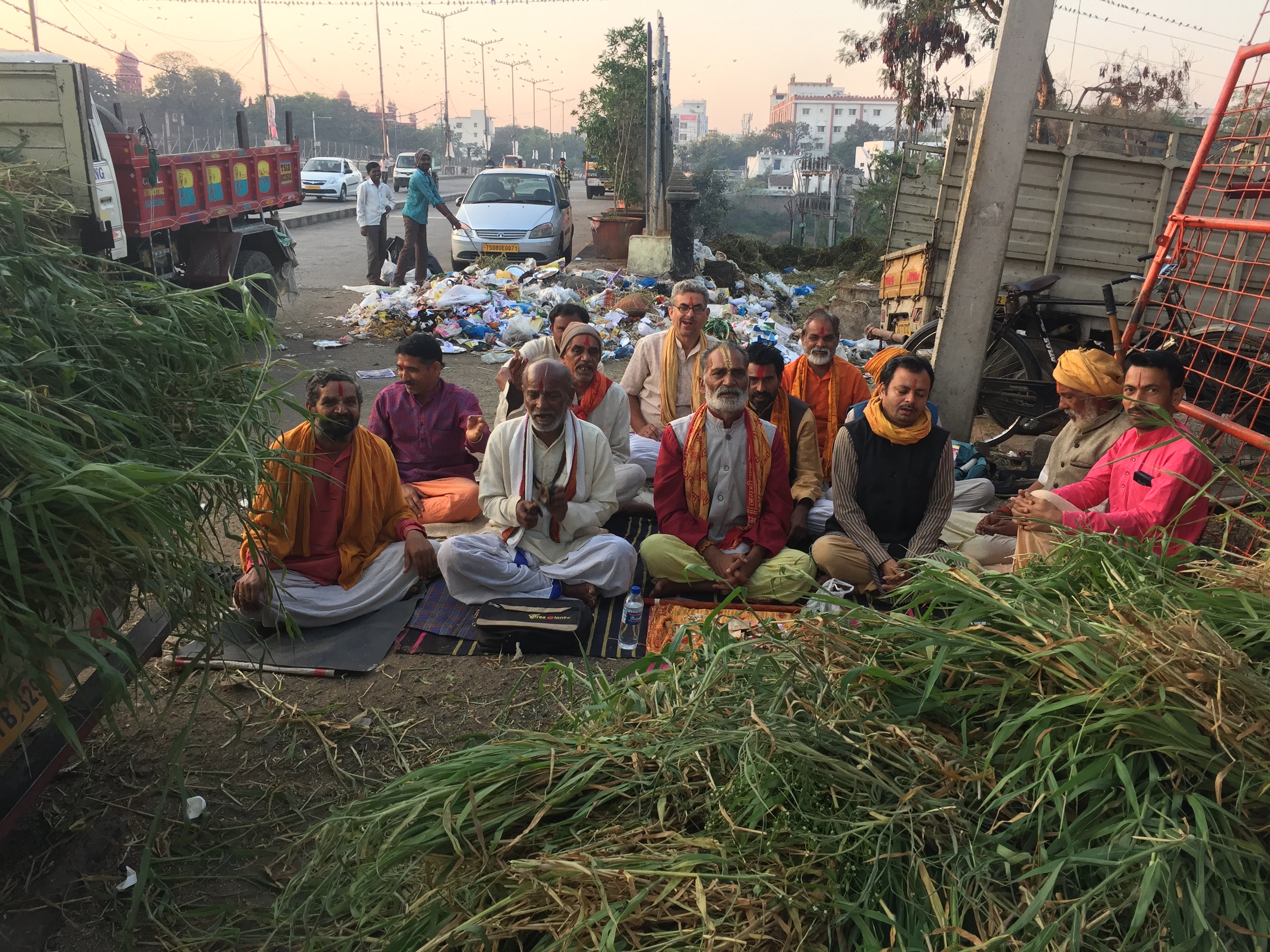
Cow devotees praying to their idols on a Hyderabad dawn (Photo: Chris Newens)
“I am not from Hyderabad but from Karnataka,” Sattar says through his consiglieri through Rahal. “There, my family were very poor. I used to sell oranges, until I made enough money to travel to Saudi Arabia for work in construction. And with that money I set up my business here.”
“Did you always know you would serve beef biryani?” I ask.
Sattar’s eyes flash at this, at the ‘B’ word – the first one. A discussion ensues between the three men in Telugu, until an answer eventually arrives my way.
“Yes.”
I wait for more, nothing comes.
“But beef is controversial in India,” I suggest. “Would it not be easier to only serve chicken and mutton?”
The translation telephone boomerangs back and forth.
“I cook the Kalyani because I know this neighbourhood,” says Sattar. “When I came here I spent my time just talking to people. I learned what they wanted.”
“And what they wanted was beef?”
“Every day I change the recipe,” again he avoids the question. “I am here every day. I eat Kalyani every day to make it better. It is because of that my restaurant is so successful.”
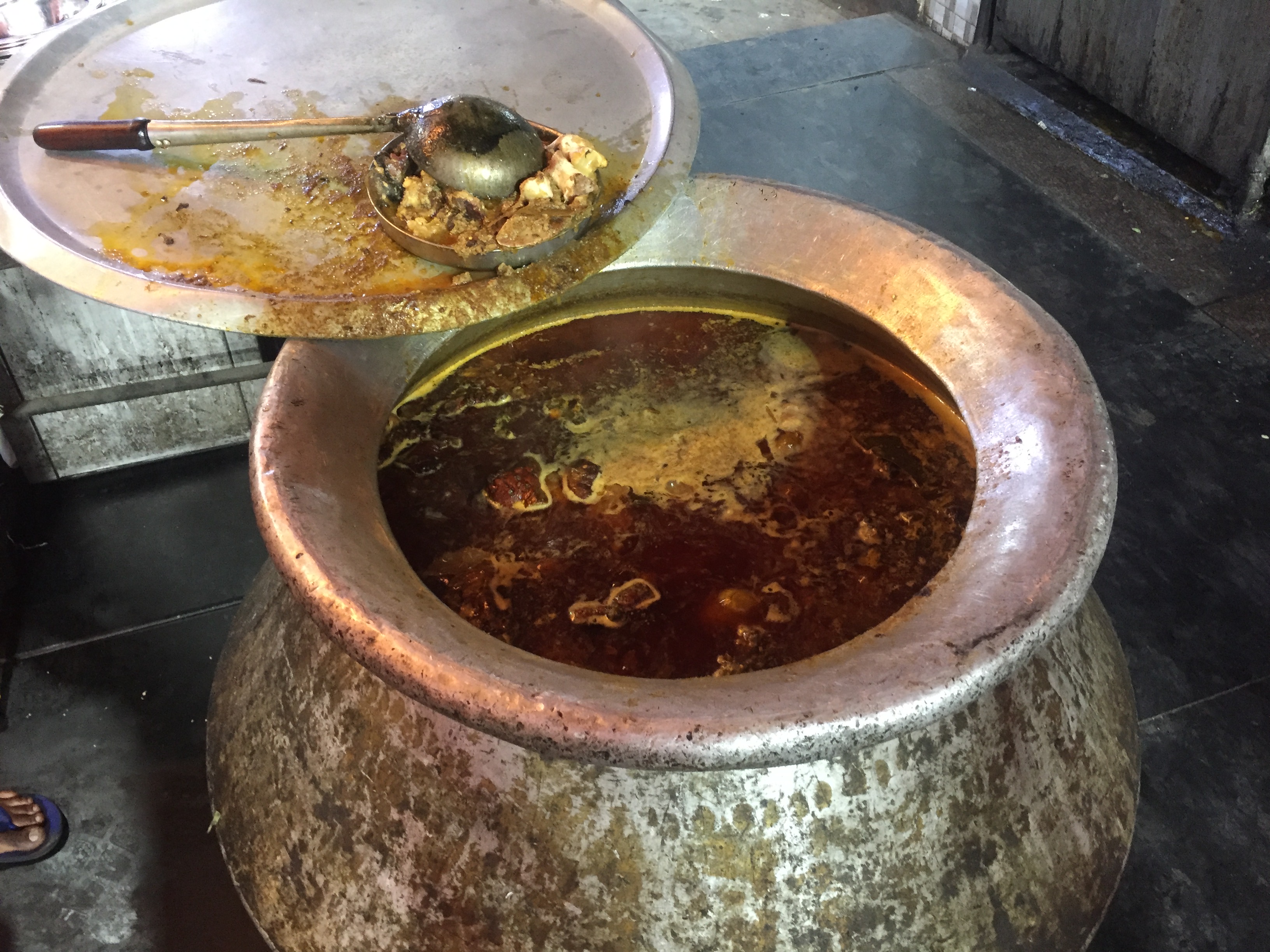
Beef bubbling outside the Al Hamdulillah (Photo: Chris Newens)
The Al Hamdulillah is a successful restaurant. Moreover, it was the only one I found serving Kalyani Biryani that was even halfway confident about the fact. All day I had spent being driven by Rahal from desolate-looking outlet to desolate-looking outlet where the biryani was served but its name barely mentioned. In a filthy cavernous hole off one of the main thoroughfares into town we were practically shouted off the establishment, “You will never be able to understand what I’ve gone through,” the owner said.
In a more central venue we were invited to the kitchens upstairs, past two great fire-hazard cauldrons being stoked beneath wooden rafters, to a pokey office where three heavies instructed both Rahal and I to hand over our phones. I thought we were being robbed, but Rahal explained they just wanted to scare us, to teach us not to put our noses where they didn’t belong. Sure enough, after five minutes, our phones were returned.
“It’s probably not even the beef,” my guide said as we left. “Those were bad fellows, man. You don’t go telling bad fellows you’re a journalist.”
The Al Hamdulillah was different. Taking up an entire building of its own on a bustling crossroads right in the heart of Hyderabad’s old town, its produce was left outside for all who cared to look: a great tray of freshly baked shins, cauldrons of stock and gelatinous marrow, and baskets of bones. Yet even here, I noted, there was no mention of beef in the branding. Even the menu did not mention the meal that literally every customer had come to eat.
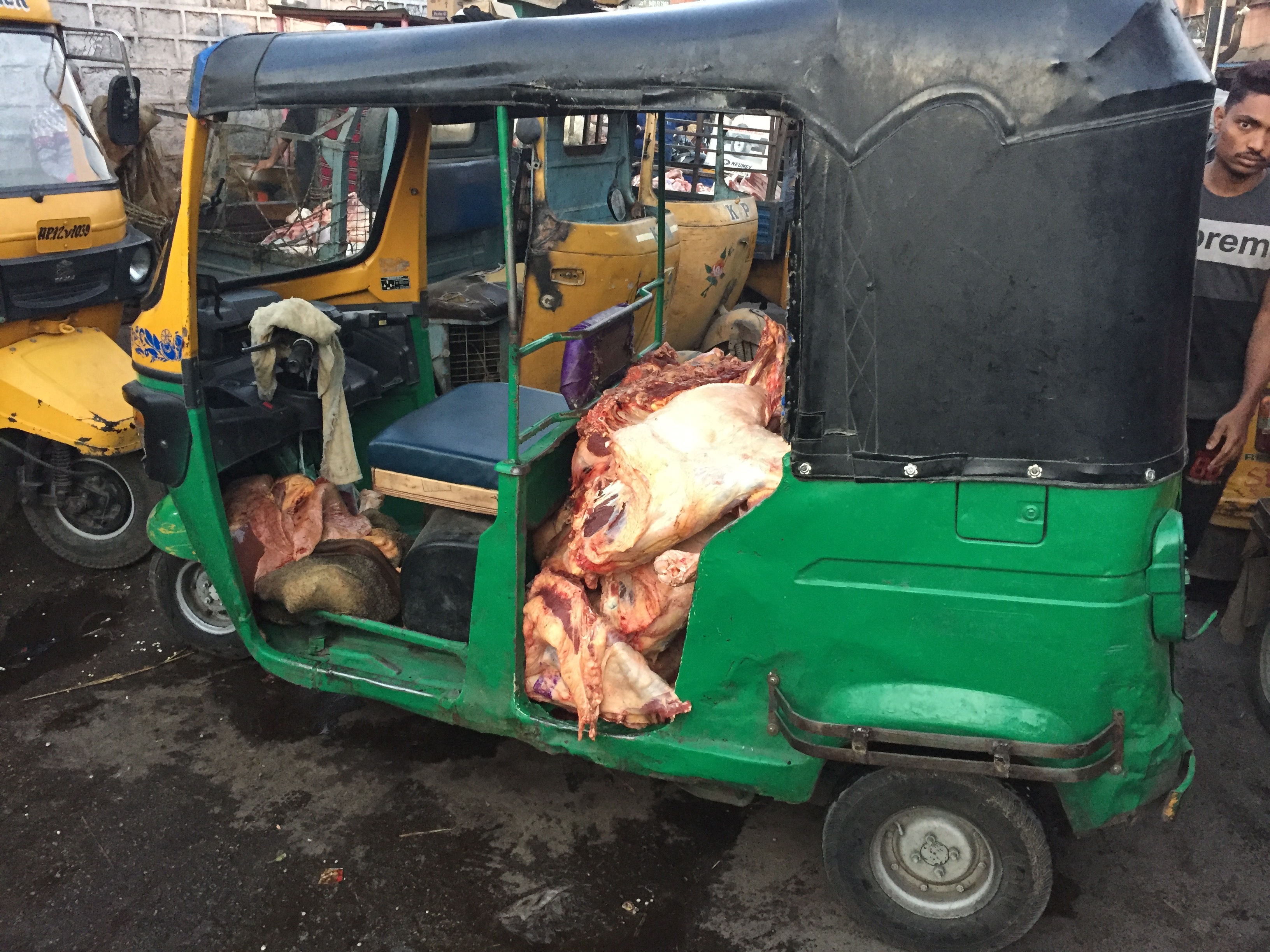
Beef delivery (Photo: Chris Newens)
“Legal, legal,” Sattar says himself, leaning toward me slightly, fixing my eyes with his own – the whites are very white, and he has a diamond shaped pupil.
“You’ve got to be careful, man,” Rahal says to me. “You ask these questions about beef, it’s like you’re accusing him of something.”
I try to protest that I am not, that I am a beef eater too, that I just want to understand the difficulties involved in running a beef restaurant in India.
“I mean,” I say, “how come he doesn’t mention beef on the menu?”
I should know that I am pushing my luck, that I am pushing Abdul Sattar’s patience, but I ask Rahal to translate anyway.
“Because people know,” comes Sattar’s response, then he smiles, wide and ingratiating; a real host’s smile. “Here, you will have our biryani, now.”
And I realise the mistake I’ve been making. Sattar does not trust me because I have not shared his table, and until I do that I am an outsider to this place. And it’s not only due to the controversy surrounding the meat; there’s a straight up question of hospitality involved too.
“Of course,” I say.
A biriyani is immediately ordered into my presence.
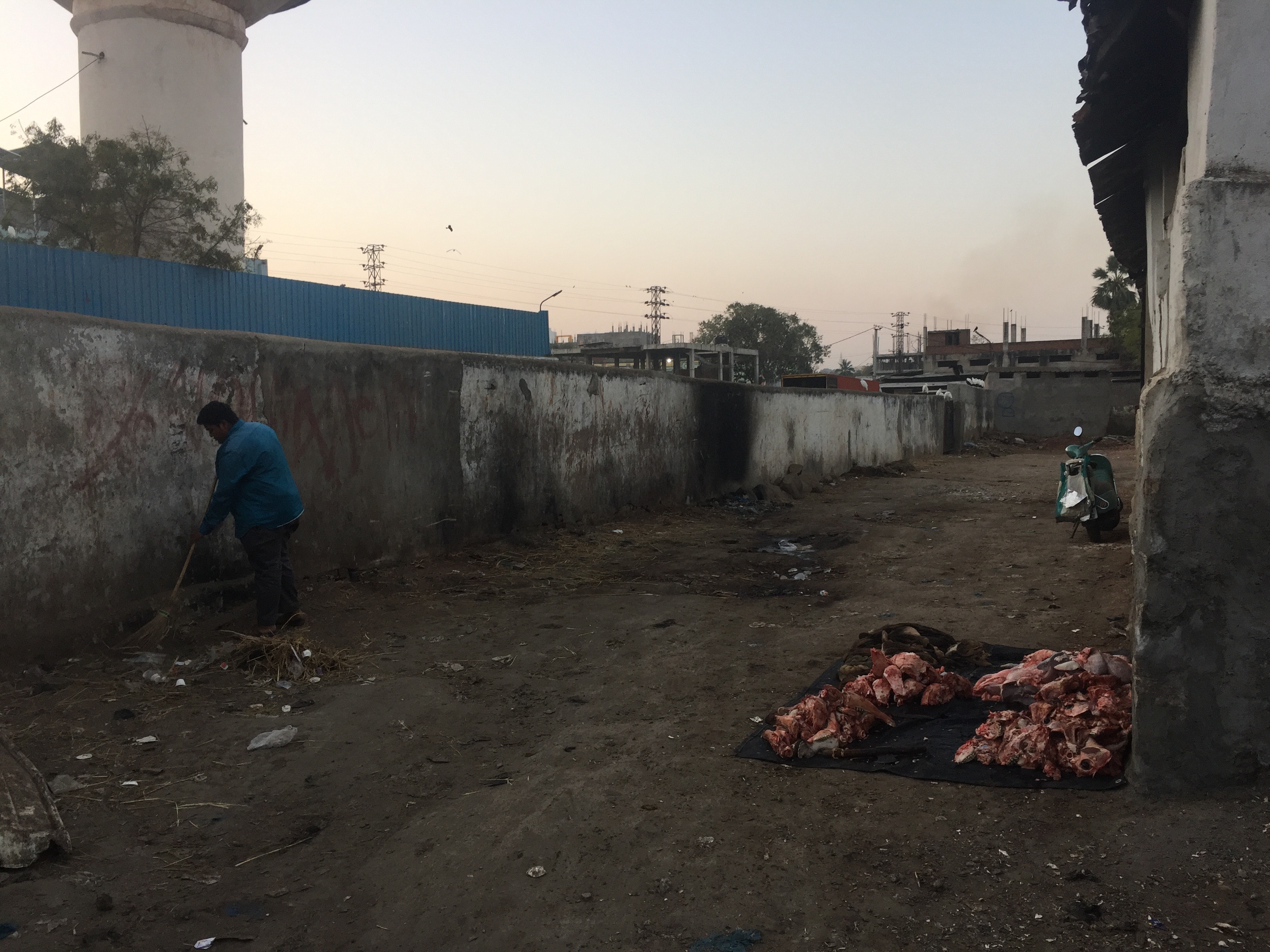
Beef off cuts for sale outside Hyderabad’s main cattle market (Photo: Chris Newens)
The meal is beefy. I know, what did I expect? But what I mean is that it is quite extraordinarily, grab you by the kameez beefy. Like someone has taken the essence of a whole 1000lbs cow then distilled it down until it fits on the size of a dinner plate. I guess this is not so far from how it is made – think of those miscellaneous pots on the long bubble outside. There is marrow in it, and gravy, and tender morsels of fall-off-the-bone succulence; and yet somehow, despite all this, there’s a lightness here as well. A lifting thanks to the fresh rice and the perfected melange of spices – cardamom, cinnamon, and cumin pulsate through it with subtle suggestiveness. It’s a meal worthy of a nawab, no doubt. And yet it’s also only 95 rupees – this, as opposed to the 135 rupee chicken or lamb alternatives.
Abdul Sattar and his consiglieri had left the table for my tasting – had gone to chat with other customers, to taste the levels of today’s creation. But now he is back, looming over me with a grin, and an unmistakable pride in his diamond eyes. For he knows that I understand.
I understand that while, yes, it is a question of tradition and resistance, there’s also a simpler truth to why Hyderabadis continue to line up for this dish everyday throughout the city despite the dangers and controversies it courts. They do so because it is mind-blowingly tasty, and because it is cheap, and because throughout human history that is a combination that no ideology nor physical threat has ever found a way to defeat.